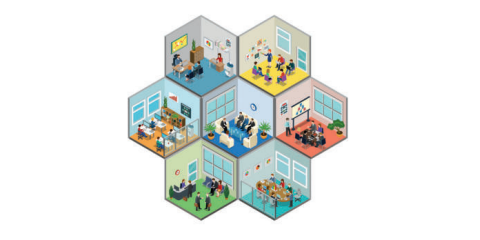What will future cities be made up of
- 30.01.2020
- Corporate Blog & News

Perfect cities don’t exist, but at least some of them learn from past mistakes. By the year 2050, the population of our planet will have reached 9.8 billion people. About 70% of them will be living in cities and suburbs. Premier Club Magazine presents some of the ruling principles that international experts say will be at the heart of developed cities in the future.
Urban hubs
The density of urban population is increasing, so it is becoming necessary to create separate zones which will be autonomously provided with water, food and recreational facilities. Different cities interpret this global vision on different scales – for example, Barcelona is already experimenting with so-called ‘superblocks’. High-capacity public transport will decrease pollution and boost transit speed.
In addition to this, the cities of the future will use the resources and opportunities provided by their green zones to maximum effect – from green roofs to fi ltration systems and rain-water recycling.
Transport
Regional high-speed rail stations will become centers for business and social activity, not just arrival and departure points.
Water
Instead of sewers, special collections systems will fi lter and direct rainwater into open pools, where it will be re-used.
Green roofs
Even today, solar panels and roof gardens aren’t a novelty – they provide reliable energy and stimulate small business. As a bonus, they also look attractive.
Smart buildings
A few years ago, the most developed cities on the planet mainly strove to awe their competitors with the scale and shape of their central buildings. But in the upcoming years urban planning will be all about the ‘smart’ trends. And we’re not just talking about the technological equipment.
In the future, more and more skyscrapers will be modular constructions – this will allow them to be built faster and with less pollution. The inner spaces will be able to swiftly transform depending on the business, residential or manufacturing needs.
The main buildings in the most developed cities will also become much more sustainable. Their main mission will be to consume less resources for their maintenance and become more useful for the local communities.
Windows and walls with solar panels
Why limit yourself to a small piece of the roof when installing solar panels? Solar panels mounted on all of the facade surfaces will catch a lot more sunlight energy.
Not just skyscrapers
Comparatively low buildings, constructed for special purposes, allow more sunlight and fresh air to reach the ground. This improves the health and well-being of the community.
More greenery
Even if they are located on the top fl oors, green zones improve the natural fl ow of air in the building, at the same time creating shade and new spaces for social interaction. Water fi ltration, monitoring of the environment and local greening will all become part of the landscape.
Public zones
Of course, the radical transformation of future cities can’t be limited to external renovations, New communities need to re-think open public spaces and their own role in them.
Common spaces and facilities improve interactions among people and allow the creation of smaller lodgings. This trend (or a slightly distorted version of it) is apparent even today, in the construction of tiny micro-apartments.
But all of this is a public and fi nancial reaction to the stable growth of the urban population and the shrinking of spaces available to us. National institutions, not only private businesses, should pay attention to the new functions of public zones. National institutions of the future will be focused on creating a feeling of belonging and social equality.
Inner gardens
With less cars outside (the most developed cities in the world are already aiming for this) and more plants inside, the quality of air and attractiveness of certain zones of the building will improve.
Openness for everyone
The development of public transport and the inclusivity of public spaces should help create zones, in which whole families – old and young – will be able to spend time together. Buildings will also be comfortable for people with disabilities.
Reuse
Instead of dumping them into a landfi ll, it is better to reuse or recycle used non-biodegradable clothes and household items. The cities of the future will take this into account.
A chance of scenery
One of the characteristic traits of a future city is that it develops as a harmonious ecosystem, not just a sum of unconnected parts. We need to change the way we think about public and personal spaces, about the functions and effectiveness of our buildings. And the most extensive aspect of this is the way a city influences the environment around it, and protection of resources that give it life.
In the city districts of the future, everything we need to satisfy most of our daily desires should be in walking distance. People will have different housing options and everyone will be able to live close to their place of work and not feel disconnected from public and cultural life. And there will be recreational zones which will take care of the ecology and public health.
Clean energy
Lighter and cheaper wind-generators will be located on the roofs of the buildings, providing additional energy to the electricity created by solar panels.
More water
About a third of natural wetlands have been lost globally since 1970. Future cities will conserve and restore the ones that are left.
Transformer buildings
Abandoned malls and empty industrial parks – could there be a sadder illustration of the previous economic systems? The modular buildings of the future will be able to be disassembled and refurbished in order to change along with the economy and technological innovations.
